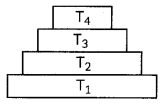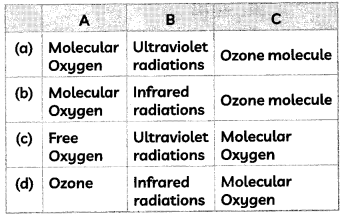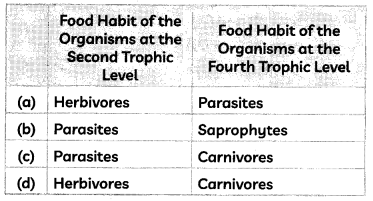Our Environment Class 10 MCQs Questions with Answers
Question 1.
In the given food chain, suppose the amount of energy at the fourth trophic level is 5 kJ, what will be the energy available at the producer level?
Grass Grasshopper → Frog → Snake → Hawk
(a) 5 kJ
(b) 50 kJ
(c) 500 kJ
(d) 5000 kJ
Answer:
Question 2.
The Foodweb is constituted by:
(a) relationship between the organisms and the environment
(b) relationship between plants and animals
(c) various interlinked food chains in an ecosystem
(d) relationship between animals and the environment
Answer:
Question 3.
In an ecosystem, the 10% of energy available for transfer from one trophic level to the next is in the form of:
(a) heat energy
(b) light energy
(c) chemical energy
(d) mechanical energy
Answer:
Question 4.
Choose the incorrect statement from the following:
(a) Ozone is a molecule formed by three atoms of oxygen.
(b) Ozone shields the surface of the Earth from ultraviolet radiations.
(c) Ozone is deadly poisonous
(d) Ozone gets decomposed by UV radiations
Answer:
Question 5.
Organisms of a higher trophic level which feed on several types of organisms belonging to a lower trophic level constitute the:
(a) food web
(b) ecological pyramid
(c) ecosystem
(d) food chain
Answer:
(a) food web
Explanation: Organisms of a higher trophic level feeding on several types of organisms belonging to a lower trophic level constitute the food web.
Question 6.
Expand the abbreviation GAP:
(a) Governmental Agency for Pollution Control
(b) Gross Assimilation by Photosynthesis
(c) Ganga Action Plan
(d) Governmental Agency for Animal Protection
Answer:
(c) Ganga Action Plan
Explanation: GAP, 1985 came in existence to check water pollution in river Ganga.
Question 7.
Which of the following are biodegradable substances?
(a) Glass bottle, Grass
(b) Jutebag, polythene bag
(c) Cotton cloth, vegetable peels
(d) DDT, Pen refill
Answer:
Question 8.
Which of the statement is incorrect?
(a) Producers form the first prophic level.
(b) Produces trap solor energy and transform it into chemical energy in food.
(c) All plants are producers.
(d) Nutrients and energy enter the living world through producers.
Answer:
Question 9.
Which of the following limits the number of trophic levels in a food chain?
(a) Decrease in energy at higher trophic levels
(b) Deficient food supply
(c) Polluted air
(d) Water
Answer:
Question 10.
In the given figure, the various trophic levels are shown in a pyramid. At which trophic level is maximum energy available?

(a) T4
(b) T2
(c) Ti
(d) T3
Answer:
Question 11.
Disposable plastic plates should not be used because:
(a) they are made of materials with light weight
(b) they are made of toxic materials
(c) they are made of biodegradable materials
(d) they are made of non-biodegradable materials
Answer:
Question 12.
Which one of the following stakeholders of forests causes the maximum damage to forest?
(a) People who live in or around the forest
(b) The forest department of the government
(c) The wildlife and native enthusiasts
(d) The industrialists
Answer:
(d) The industralists
Question 13.
Food web is constituted by:
(a) Relationship between the biotic and abiotic components of ecosystem.
(b) Relationship between abiotic compo-nents and recycling of nutrients.
(c) Relationship between biotic compo-nents and biogeochemical cycles.
(d) Various interlinked food chains in an ecosystem.
Answer:
Question 14.
Consider a terrestrial food chain: Grass Grasshopper → Frog → Snake → Eagle
The energy transfer in the above food chain will be from:
(I) Producer to decomposer
(II) Producer to primary consumer
(III) Primary consumerto secondary consumer
(IV) Tertiary consumerto Secondary consumer
(a) Both (I) and (III)
(b) Both (I) and (IV)
(c) Both (II) and (III)
(d) Both (III) and (IV)
Answer:
Question 15.
Which of the statements regarding food chain are correct?
(I) All food chains are of equal length and complexity.
(II) Food chains generally consist of only three or four steps.
(III) The greatest number of organisms in a food chain is of the producers.
(IV) Relationships between organisms can be shown only by straight lines.
(a) Both (I) and (II)
(b) Both (II) and (III)
(c) Both (III) and (IV)
(d) (II), (III) and (IV)
Answer:
Question 16.
Ozone-depleting substances are chiefly utilized in
(I) chimneys
(II) cooling and refrigeration applications and in the manufacturer of foam products
(III) all of the human activities
(IV) burning fossil fuels
(a) Only (I)
(b) Only (II)
(c) (I), (II) and (IV)
(d) (II), (III) and (IV)
Answer:
Question 17.
Consider the chemical reactions taking place at upper atmosphere:
![]()
Select the row containing the correct naming of A, B and C.

Answer:
(a) A: Molecular oxygen; B: Ultraviolet radiations; C: Ozone molecule
Explanation: Ozone at the higher levels of the atmosphere is a product of Ultraviolet radiation acting on oxygen (02) molecule. The higher energy UV radiations split apart some molecular oxygen (O2) into free oxygen (O) atoms and these atoms then combine with the molecular oxygen to form ozone as shown below:
![]()
Question 18.
The food habits of the organisms at the second and fourth trophic levels of a typical terrestrial are given in the table below.
Select the row containing the correct food habits:

Answer:
Question 19.
The protocol agreed upon in 1987 organized by the United Nations Environment Programme (UNEP) is related to:
(a) Food security
(b) Ozone layer depletion
(c) Global warming
(d) Sustainable deveLopment
Answer:
(b) Ozone Layer depletion
Explanation: In 1987. the United Nations Environment Programme (UNEP) succeeded in forging an agreement to freeze CFC production at 1986 Levels in order to stop the depletion of ozone layer.
Question 20.
The formation of ozone in the stratosphere is powered by:
(a) UltravioLet radiation
(b) Infrared radiations
(c) Atmospheric oxygen
(d) CFC
Answer:
Question 21.
Which organism shown in the food chain above wouLd Contain the greatest concentration of chemical pollutants?
Phytoplankton → Krill → Small fish → Tuna → Shark
(a) Phytoplankton
(b) KriLl
(c) Tuna
(d) Shark
Assertion Reasoning questions Class 10 Science Chapter 15
For the following questions, two statements are given one labeled Assertion (A) and the other Labeled Reason (R). Select the correct answer to these questions from the codes (a), (b), (c) and (d) as given beLow:
(a) Both (A) and (R) true and (R) is correct explanation of the assertion
(b) Both (A) and (R) are true and (R) is correct Explanation of the assertion.
(c) (A) is true, but (R) is false.
(d) (A) is false, but (R) is true.
Question 22.
Assertion (A): Green plants of the ecosystem are the transducers.
Reason (R): Producers trap the radiant
energy of the sun and change it into chemical energy.
Answer:
(a) Both (A) and (R) are true and (R) is the correct explanation of assertion. Explanation: Green plants can make their own food. Hence, they are called producers. Since they capture the heat of the Sun to prepare their food, they are also called transducers. The plants prepare their food by trapping the energy of the Sun. They convert this light energy to chemical energy to form ATP molecules.
Question 23.
Assertion (A): Food chains generally consist of only three to four steps.
Reason (R): Autotrophs capture solar energy and convert it into chemical energy.
Answer:
Question 24.
Assertion (A): The maximum concentration of chemicals and pesticides occurs at the first trophic leveL
Reason (R): The chemicals and pesticides are not biodegradable.
Answer:
Question 25.
Assertion (A): Ozone shields the surface of the earth from ultraviolet radiation from the sun.
Reason (R): Ozone at the higher levels of the atmosphere is a product of UV radiations acting on oxygen molecules.
Answer:
(a) Both (A) and (R) are true and (R) is the correct explanation of assertion. Explanation: Ozone is formed when the high-energy UV radiations act on oxygen molecules (O2) and split it into free oxygen atoms (O) which combine with the molecular oxygen to form ozone (O3). Ozone thus shields the earth’s surface from the harmful effects of UV radiation.
Question 26.
Assertion (A): Improvements in our lifestyle have resulted in lesser amounts of waste material generation.
Reason (R): Changes in packaging have resulted in much of the waste generated being non-biodegradable.
Answer:
(d) (A) is false, but R is true.
Explanation: Improvements in our lifestyle have resulted in greater amounts of waste material generation due to changes in attitude and more and more things we use becoming disposable, which are also non-biodegradable.
Question 27.
Assertion (A): Frogs mostly occupy the second trophic level in food chains.
Reason: Frogs mostly feed on insects that depend on plants.
Answer:
(d) A is false, but R is true.
Explanation: Frogs mostly occupy the third trophic level in the food chain since they feed on insects which depend on plants and plants are the primary producers thus they occupy the first trophic level in the food chain. Thus A is false, but R is true.
Question 28.
Assertion(A): In the food chain third trophic level is occupied by Carnivores.
Reason(R): Some of the carnivores are secondary consumers.
Answer:
Question 29.
Assertion (A): Each step of the level of the food chain forms a trophic level.
Reason (R): The organisms occupying the first trophic levels are called autotrophs.
Answer:
(a) Both (A) and (R) are true, and (R) is the correct explanation of the assertion.
Question 30.
Assertion (A): Each step or level of the food chain forms a trophic leveL
Reason (R): The various components of the ecosystem are interdependent.
Answer:
Question 31.
Assertion (A): Polythene bags are non-biodegradable substances.
Reason (B): These bags cannot be broken down by microorganisms to simpler substances.
Answer:
Question 32.
Assertion (A): The food chains generally consist of only three or four steps.
Reason (B): Our food grains such as wheat and rice, vegetables and fruits and even meat contain varying amounts of pesticides.
Answer:
(b) Both (A) and (R) are true, but (R) is not the correct explanation of the assertion.
Explanation: The food chains generally consist of only three or four steps because after that the energy added to the biomass of each level is reduced and at the fourth trophic level it will be least. Thus Both A and R are true, but R is not the correct explanation of the assertion
Question 33.
Assertion (A): The amount of ozone in the atmosphere began to increase sharply in the 1980c.
Reason (R): The United Nations environment program (UNEP) succeeded in forging an agreement to freeze CFC production in 1987.
Answer:
(d) A is false, but R is true.
Explanation: The amount of ozone in the atmosphere began to decrease sharply in the 1980s because of the United Nations environment program (UNEP) succeeded in forging an agreement to freeze CFC production in 1987. Thus A is false, but R is true.